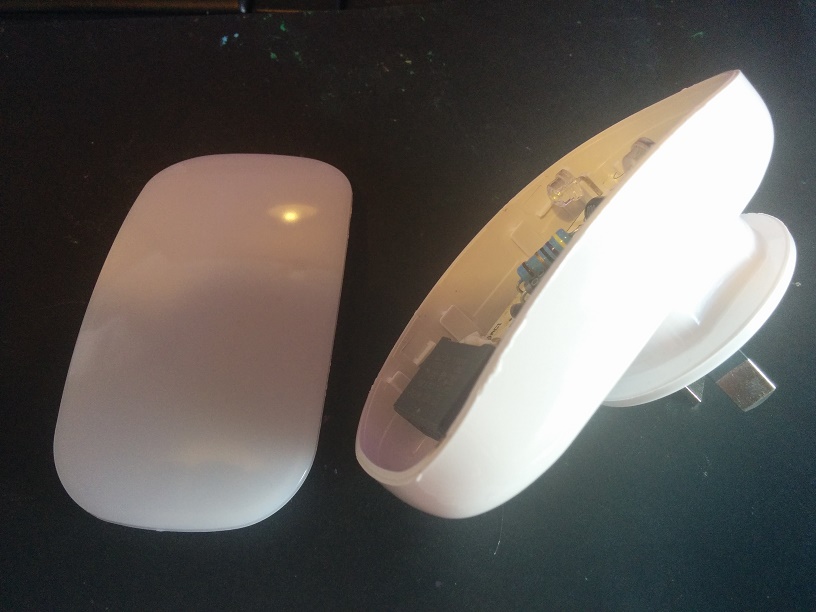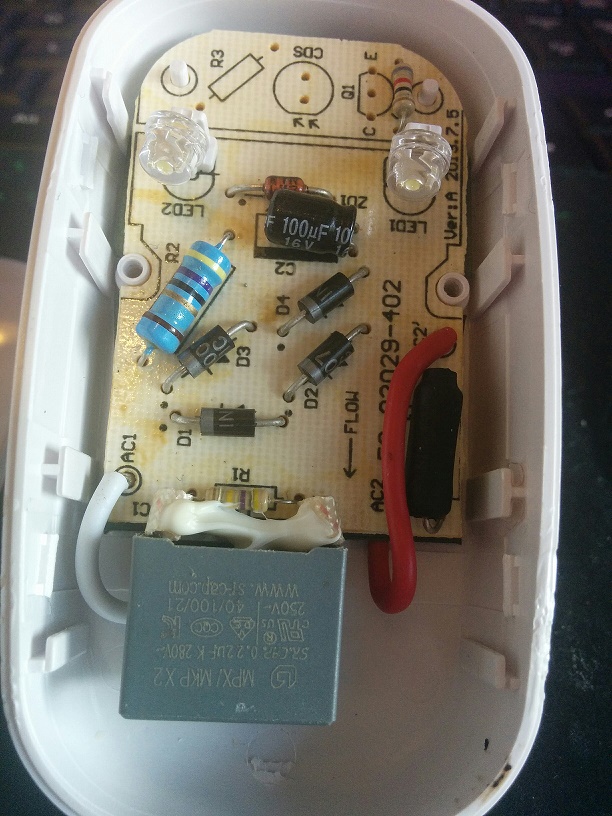Retrofit sensors into 240v LED Night Light : Help a novice?
-
At the moment my sensors are plugged into USB phone chargers and are just a mess of ugly wires.... My mission is to now package it up nicely into an environment sensor that can just be plugged into any wall socket and not look too out of place.
My "bright" idea is to start of with a cheap generic 240v LED night light which can be bought for about $5 and then try and retrofit an arduino and a couple of sensors into it without changing the appearance.
These are some photos of the LED Night Light with the cover removed.


I must confess that my knowledge of electronics and diodes, resistors etc is VERY limited and almost none! I don't want to fry any components or cause a fire so any help would be appreciated...
My plan is to remove the LEDs and "tap" into the power supplied to them.
Each one gets supplied with 3v based on my testing, ideally I'd like to get a clean 5v to power the arduino/sensors.... So I'm assuming I can daisy chain them giving me 6v which I could then get back down to 5v using some little device?Is this the right approach or is there a better way based on what you can see in the photos?
-
At the moment my sensors are plugged into USB phone chargers and are just a mess of ugly wires.... My mission is to now package it up nicely into an environment sensor that can just be plugged into any wall socket and not look too out of place.
My "bright" idea is to start of with a cheap generic 240v LED night light which can be bought for about $5 and then try and retrofit an arduino and a couple of sensors into it without changing the appearance.
These are some photos of the LED Night Light with the cover removed.


I must confess that my knowledge of electronics and diodes, resistors etc is VERY limited and almost none! I don't want to fry any components or cause a fire so any help would be appreciated...
My plan is to remove the LEDs and "tap" into the power supplied to them.
Each one gets supplied with 3v based on my testing, ideally I'd like to get a clean 5v to power the arduino/sensors.... So I'm assuming I can daisy chain them giving me 6v which I could then get back down to 5v using some little device?Is this the right approach or is there a better way based on what you can see in the photos?
@TommySharp I personally think you are playing with fire here. If working mains voltages you should have knowledge of what you are doing.
The is no real power supply in these lights so you need to create a safe one.
I suggest you search the forum and open hardware.io projects for some alternatives and related discussions. There is a good chance you find something which fits and stay alive. -
Thanks @AWI , I appreciate the advice and I'm fully aware of the risks.... I'll poke around and see what other alternatives there are.... It is probably safer to go with a 5v "wall wart" and try and package something up nicely with that.
It's possible that others may have some advice on this topic too so I'll leave this post open.
-
Neither am I a specialist but I agree with the comments above, it sound like a very bad idea :
- it's a basic transformerless design with no insulation between main and the low voltage part. To be considered safe it must be completely sealed = not suitable for temperature or humidity sensors.
- given the layout and the small space available you will have to put your board/sensors right on top of the main voltage part which has no insulation.
- look at the distance between the top diode (part of the rectifier so connected to main voltage) and the 100uF capacitor rated for 16V so part of the low voltage circuit, only a tiny distance with wires exposed, it doesn't look good at all and it must be even worse from the other side with the solder !
Check the projects using the HLKPM0x transformers + some extra components for safety, it won't be that small but at least it will not burn your house.
For simple sensors you should also consider using battery power: battery powered sensor can can be small, anywhere (can be hidden in anything non metallic), and it's 100% safe. -
How about using one of these?
http://www.futureelectronics.com/en/technologies/electromechanical/power-supplies/ac-dc/Pages/6008673-RAC02-05SC.aspx?IM=0
These have a wide input voltage range of 90 to 277 volts. An option like this could bridge the differences in power in various countries. So if someone from the US were to build it, it would work on 120 volts whereas a build in Europe would most likely work on 240 volts. Either configuration would work making it a more flexible design.The module I linked is the 5 volt model, but they come in output voltages ranging from 3.3 to 24 volts.
-
I appreciate the concern for my well being that everyone is showing so a big thanks for that :-)
I would still like to find something that could be used to create a nice little housing for some sensors that can just be plugged straight into a plug socket. My first thought was a simply little night light but hopefully this topic could highlight some other alternatives. I have done a lot of searching the web and a night light appeared to be the best looking and cheapest approach :-)
By not being battery powered it does mean I can use sensors like PIR for motion and even install a LED to re-instate the nightlight feature but have it controlled from the Home Automation system. Always on would also allow it to be used as a repeater which is another bonus.
-
The kind of "PSU" thats is in that night light is not ideal for a mysensors application. I suggest you use this one:
https://www.domoticz.com/forum/viewtopic.php?f=42&t=7832
I think using the housing is a good idea, but please throw away those electronics.
Here in the netherlands we have a cheap ass store called "Action" where they sell those 433mhz controlled remote plug in switches. You get 3 of them + a remote control for just € 10,-. I think they can be a pretty good housing too.
